Coral Reefs (original) (raw)
Often known as the “rainforests of the sea,” coral reefs are considered the most productive ecosystems in the world that are widely known for their biological diversity and the various ecosystem services they provide. The reefs are formed primarily of calcium carbonate produced by the colonies of reef-building coral polyps. The coral reefs cover an area of approximately 109,800 mi2, accounting for just 0.1% of the surface area of the oceans. The yearly global economic value of coral reefs is estimated to be between US$29.8 billion and US$375 billion annually, and about 500 million people worldwide depend on coral reefs for their livelihood. However, at present times, anthropogenic activities have severely threatened coral reefs, leading to their decline by about 50%.
Formation And Types Of Coral Reefs
It is believed that the melting of ice during the Last Glacial Period led to an increase in sea level and flooding of continental shelves giving rise to coral reefs. Sir Charles Darwin outlined the theory of atoll reef formation in his book “The Structure and Distribution of Coral Reefs.” As per the theory, the gradual subsidence and tectonic uplift of the Earth’s crust under the mighty oceans led to the formation of atolls. Darwin also set out the three stages of atoll reef formation: at first, a volcanic island becomes extinct; secondly, the subsidence of the island and ocean floor leads to the formation of a fringing reef around the extinct volcanic island; and third, with continuous subsidence, the fringing reef gradually transforms into a barrier reef and finally into an atoll reef.
Based on the mode of formation, three distinct coral reef types can be found in various portions of our planet. These are fringing reefs, barrier reefs, and atolls.
Fringing Reefs
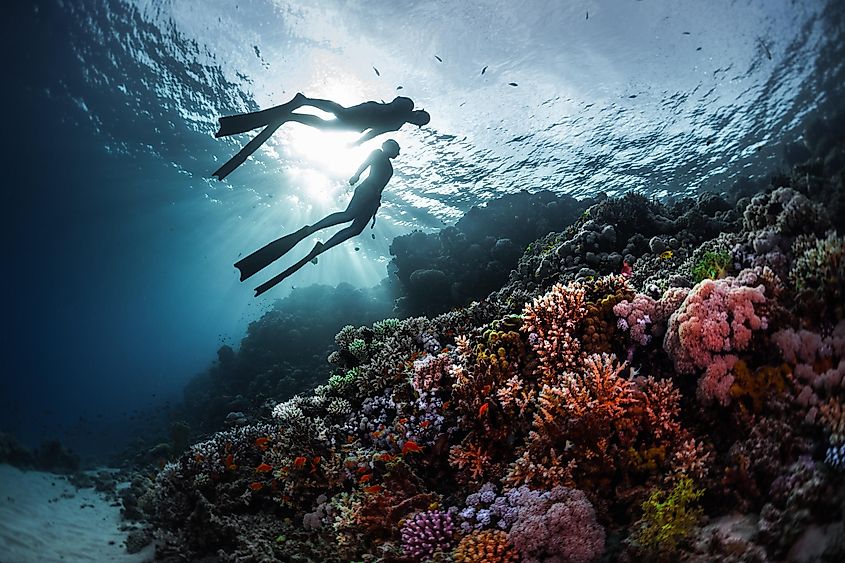
Divers exploring the fringing coral reefs of the Red Sea.
Also referred to as shore reefs, fringing reefs are located along the edges of a continent or near the shores of volcanic islands. This type of reef extends for a few miles from the shore, with an intervening, shallow water channel separating the reef edge from the shore. Considered the most common and youngest of the three coral reef types, fringing reefs are primarily made up of coral sand, mud, and dead and living colonies of corals. Fringing reefs are found on the southern coast of Florida, the Gulf of Mannar, and the New Hebrides Society Islands. The best-developed fringing reefs in the world can be seen along the Red Sea shores.
Barrier Reefs
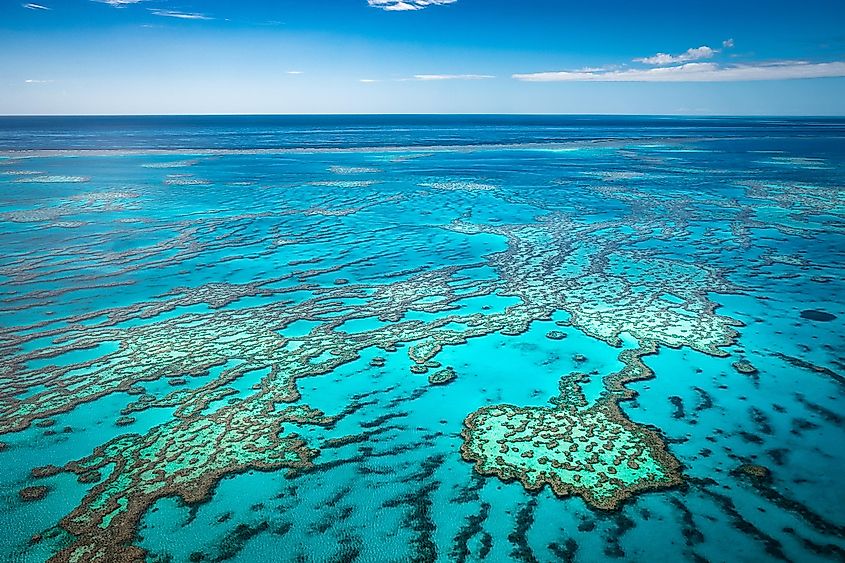
An aerial view of the Great Barrier Reef in Australia.
Considered the biggest among the three coral reef types, these large linear reef complexes develop along the continental shore edges. The barrier reefs run almost parallel to the shore and are separated by a vast, deep lagoon from the mainland. As the formation of these reefs takes more time than the fringing reefs, barrier reefs are rare. The most well-known example of this type of reef is the 1,400-mile-long Great Barrier Reef, situated off the northeastern coast of Australia. Some other notable barrier reefs include the Belize Barrier Reef and the New Caledonian Barrier Reef.
Atolls
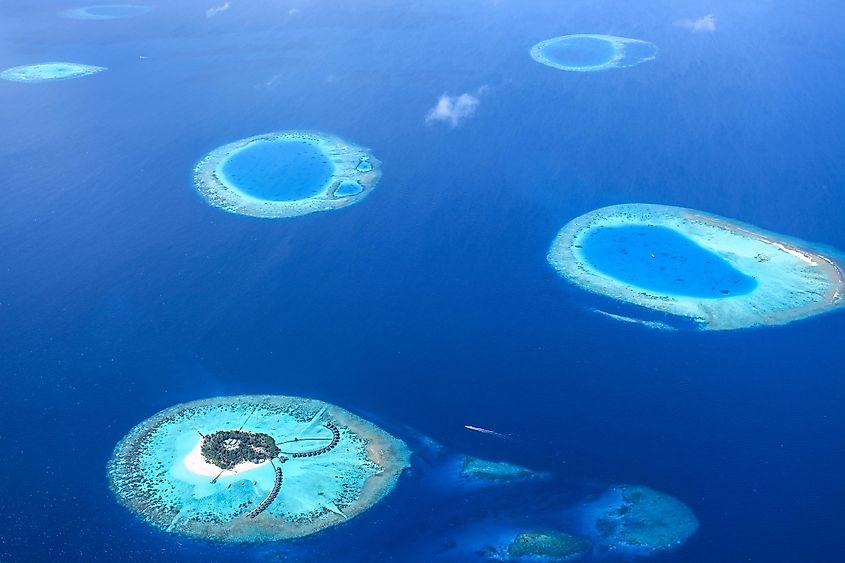
Aerial view of atolls in the Pacific Ocean.
Usually situated at the heart of the sea, atolls are horseshoe-shaped reefs that partially or wholly surround a deep central lagoon. Atolls are formed when volcanic islands encircled by fringing reefs subside into the sea. The fringing reefs continue to grow and develop a circle around the central lagoon. This circular ring is broken in some places to form channels that allow water movement, in turn linking the central lagoon and the open sea. Most known atolls are found in the South Pacific Ocean, mainly in the Caroline Islands, Marshall Islands, Cook Islands, French Polynesia, and Micronesia. Some notable atolls in the Indian Ocean include Chagos Islands, Maldives, Seychelles, and Cocos Island.
Besides these three major classical reef types, scientists and researchers have also identified some other types of coral reefs. These coral reef types include platform reefs, patch reefs, Apron reefs, ribbon reefs, bank reefs, microatolls, etc.
Conditions Required For Coral Reef Formation
Being extremely sensitive to temperature fluctuations, the reef-building corals are found in tropical and sub-tropical oceans, where the yearly water temperature ranges between 79°F to 81°F. Corals also need an optimum range of seawater salinity for their reef-building activities. It is estimated that if the salinity drops below 20ppt for over a day, it will lead to the death of corals and other reef-associated organisms. Coral polyps share a symbiotic relationship with microscopic Zooxanthellae, which reside within the polyps' tissues and nourishes them. Due to this crucial relationship of the coral polyps with the Zooxanthellae, coral reefs are commonly found in clear, sediment-free, shallow ocean waters, which admit more sunlight.
Biodiversity Of Coral Reefs
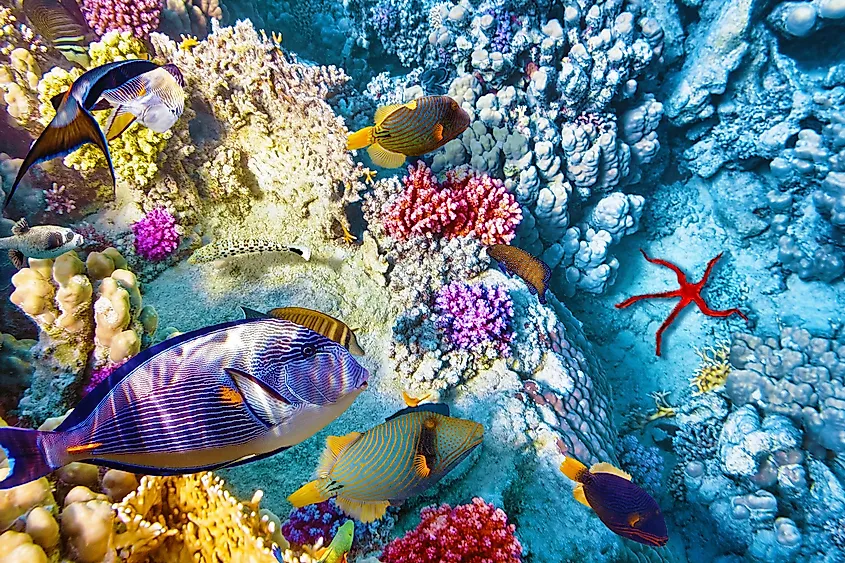
Coral reefs support a great diversity of marine life and also serve as the spawning grounds of many fish species.
The complex and varied habitats of the coral reefs harbor various marine organisms. Studies have reported that the coral reef ecosystem support approximately 250,000 known marine species on our planet, including 4,000 species of fish, 700 coral species, and numerous other aquatic flora and fauna. Different organisms like cyanobacteria, phytoplankton, seagrasses, and micro and macroalgae play the role of autotrophs in the coral reef ecosystem. The coral reefs offer an ideal habitat and a safe shelter for many fishes, echinoderms, sponges, sea turtles, crustaceans, mollusks, sea anemones, and various other marine faunal species. Some notable fishes found in the coral reef ecosystem include cardinalfish, butterflyfish, parrotfish, surgeonfish, rabbitfish, damselfish, trumpetfish, etc. Different sharks, like carpets, bamboo, white tip, and nurse sharks, are also observed on the coral reefs. In addition, the coral reef ecosystem act as critical habitat for several seabird species. For example, Hawaii’s Midway Atoll supports over 3 million seabirds, including large populations of Laysan albatross and black-footed albatross.
Importance Of Coral Reefs
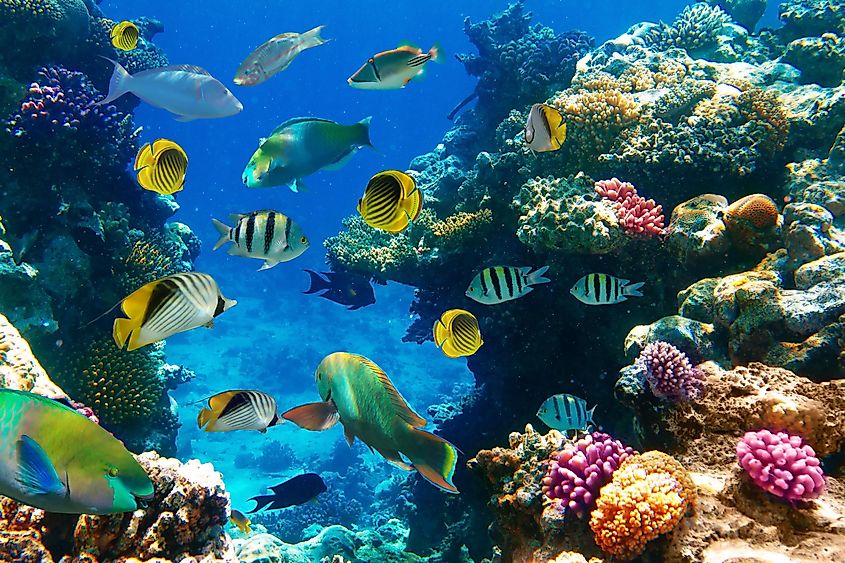
Coral reefs are rich in fish life, offering fishing opportunities to communities, and thus supporting their livelihoods.
Coral reefs offer various ecosystem services such as shoreline protection, fisheries, and tourism. Over 500 million people rely on the ecosystem services provided by the coral reefs, and the global economic value of coral reefs ranges between US$29.8 billion to US$375 billion annually. Functioning as low-crested breakwaters, coral reefs protect coastlines from the damaging effects of tropical storms and wave actions by absorbing 97% of wave energy. This helps in preventing significant property damage and loss of life. Moreover, coral reefs provide about 6 million tons of fish every year. The well-managed reefs yearly yield an average of 15 tons of seafood per square kilometer. It has also been recorded that the coral reef fisheries of Southeast Asia alone earn around $2.4 billion per year from seafood.
Threats To Coral Reefs
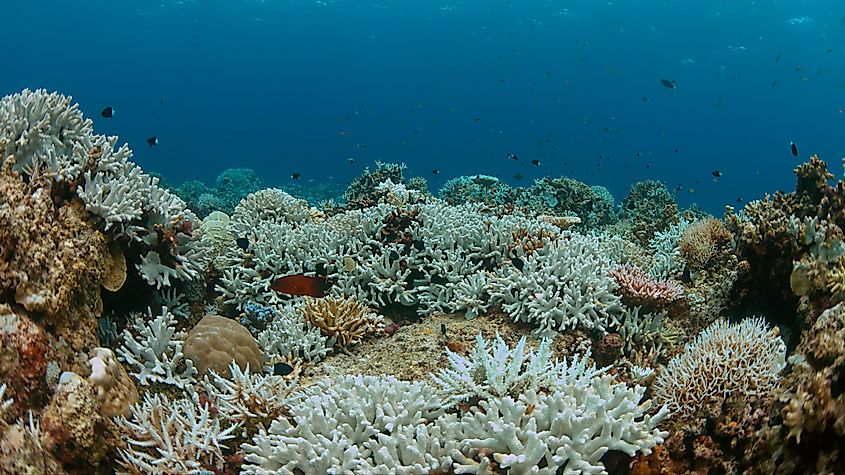
Coral reefs losing color by a process called coral reef bleaching which happens due to ocean acidification.
However, despite their varied ecosystem services to humans and other life forms, coral reefs are highly threatened due to climate change, increased greenhouse gas emissions, ocean warming and acidification, pollution, and various other anthropogenic activities. Worldwide, coral reefs have been extremely affected by global warming and climate change, which has led to the heating of the Earth’s atmosphere as well as a rise in the surface temperature of the ocean waters. The microscopic Zooxanthellae that live in the tissues of the coral polyps are pretty sensitive to high temperatures. Therefore, a slight change in the ocean water temperature will lead to the expulsion of zooxanthellae by the corals and subsequent bleaching of the coral tissues. When continuously exposed to warm ocean waters for several days, these bleached corals will die, turning the reef into a barren habitat.
Anthropogenic activities like the excessive burning of fossil fuels have increased carbon dioxide levels, making the ocean waters acidic. The carbonic acid formed as a part of this acidification process disrupts the ability of corals to build calcium carbonate exoskeletons. This makes the coral reefs more vulnerable to diseases, ultimately destroying their framework. In addition, coral reefs also face severe threats from various local sources like pollutants released into the oceans, harmful algal and bacterial growth, increased sedimentation, coral mining, toxic chemicals, marine debris, destructive fishing practices, and irresponsible tourism.
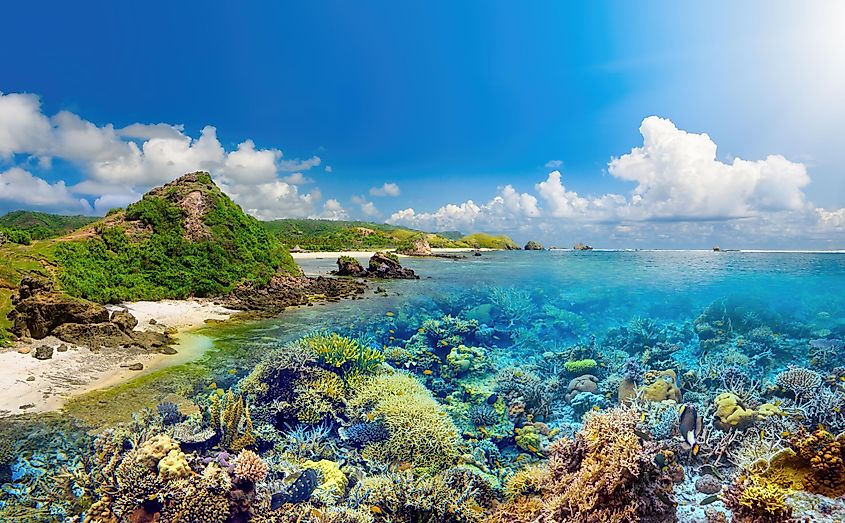
Beatiful coral reef around the island of Lombok, Indonesia.
As mentioned in the above discussion, coral reefs are highly productive aquatic ecosystems that are well-known for their rich biodiversity and the array of ecosystem services they provide. Researchers have suggested that in the next few decades, the combination of increased surface water temperatures and ocean acidification will cause major changes to the coral reefs. To help combat this, many countries have passed legislation that aims to reduce greenhouse gas emissions. Following the unprecedented death of coral reefs around the planet over the past few decades, researchers have also started “coral aquaculture” for restoring damaged coral reefs.